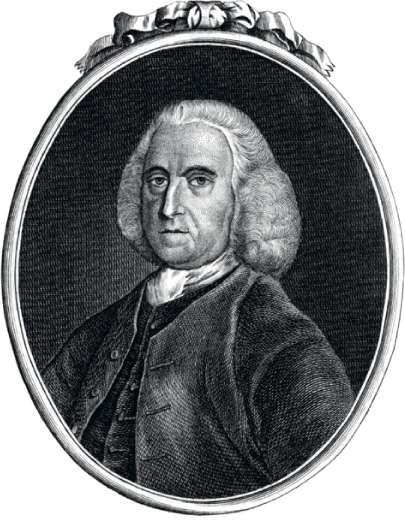
Peter Collinson (1694–1768).
In the middle of the eighteenth century, there was no way to generate electric currents (see here), but scientists were familiar with the ‘static’ electricity that can be made by friction, for example by rubbing a glass rod with a silk cloth. This is the same kind of electricity that crackles on a dry day when you pull up a sweater made of synthetic material, and a rod charged up in this way will produce a spark when it is touched to another object. These sparks are like miniature lightning bolts, which led people to speculate that lightning might be a form of electricity. The person who took up the challenge of proving this was the American savant Benjamin Franklin. In 1746 Franklin acquired a glass rod from Peter Collinson, a merchant with an interest in science, who was a Fellow of the Royal Society. He carried out a series of experiments with it.

These experiments convinced Franklin that storm clouds must be electrically charged, like a glass rod rubbed with silk, and that lightning occurred when this static electricity was discharged to the ground, like the sparks that flew when the rod came near another object. But how could this idea be tested? Franklin wrote about his experiments in letters he sent to Collinson in England, and suggested that a tall metal rod, or spike, might be erected during a thunderstorm to draw off electricity from the clouds. The idea was not to encourage lightning to strike the metal rod, but to draw the electricity off gently and capture it in a special kind of glass bottle, known as a Leyden (or Leiden) Jar. Apart from Collinson, nobody at the Royal Society was enthusiastic about Franklin’s ideas. But Collinson had them published in the early 1750s, and they were widely read by scientists in mainland Europe.
One of those scientists, Thomas-François d’Alibard, decided to put Franklin’s idea to the test. In May 1752 he set up a 40-foot (12-metre) high metal spike in a garden in Marly-la-Ville, in northern France, and drew off sparks from it during a storm. The rod was not, however, struck by lightning, which probably would have killed d’Alibard. Before news of this success could reach America, Franklin had carried out his own version of the experiment in Philadelphia, by flying a kite during a thunderstorm in June 1752.
Like d’Alibard, Franklin knew that it would be dangerous to be struck by lightning, and was simply trying to draw off some of the electric charge from the clouds, along the wet string of the kite to a key attached to the string. To encourage this, a pointed wire was attached to the kite itself, but as a safety precaution he held the kite by a silk ribbon, attached to the string of the kite, as an insulator. Sure enough, electricity was drawn down to the key, and, when an object was moved close to the key, sparks flew across the gap. Franklin even let the sparks leap across, painfully, to his own knuckles.

Soon after he had carried out his own experiment, Franklin heard of d’Alibard’s success in France. In October 1752, he wrote to Collinson with directions on how to repeat his own experiment: ‘When rain has wet the kite twine so that it can conduct the electric fire freely, you will find it streams out plentifully from the key at the approach of your knuckle, and with this key a phial, or Leiden jar, may be charged: and from electric fire thus obtained spirits may be kindled, and all other electric experiments [may be] performed which are usually done by the help of a rubber glass globe or tube; and therefore the sameness of the electrical matter with that of lightening completely demonstrated.’6
Other experimenters were not so careful – or rather, not so lucky – as Franklin, and several people were killed by lightning while trying to copy what he had done. In Franklin’s case, the electricity was drawn down gradually from the clouds, but he was wrong to think that lightning itself could not strike via the kite. The same flawed thinking was behind his invention of the lightning conductor, in the form of a metal rod attached to the highest point of a building and connected to the earth by a wire. He thought that such a rod would draw off electricity gradually, and prevent a lightning strike. In fact, such a lightning conductor encourages the lightning to strike, but protects the building by acting as a direct route to earth for the lightning, which strikes the metal rod rather than the building itself. But either way, it does work! And all of this proved that lightning is indeed the same phenomenon as static electricity, but on a larger scale.